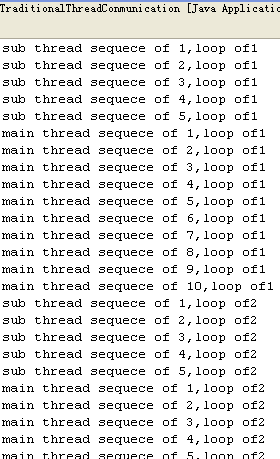线程之间的通信应该注意两个类:
wait();
notify();
题目:子线程循环5次,接着主线程循环10次,接着有回到子线程循环5次,
接着再回到主线程循环10次,如此循环2次,请写出程序。
分析:这里的子线程和主线程在执行的时候都需要保护,即子线程执行的时候,主线程不能打断;主线程在执行的时候子线程不能打断。
注意:这里的数字比较小,但写出的代码应该可以简单修改,就可以执行循环次数大的线程通信。
- 1-1 一个线程通信的简单例子
- public class TraditionalThreadConmunication {
- public static void main(String[] args) {
- final Business business=new Business();
- new Thread(
- new Runnable() {
- @Override
- public void run() {
- for(int i=1;i<=2;i++){
- business.sub(i);
- }
- }
- }
- ).start();
- for(int i=1;i<=10;i++){
- business.main(i);
- }
- }
- }
- class Business{//将线程访问的资源同步,而不是将线程同步,
- //好处:以后交给其他的线程访问,不用考虑线程的同步
- private boolean bShouldSub=true;//刚开始子线程执行
- public synchronized void sub(int i){//子线程
- //此处while和if的效果是一样的,但是while防止伪唤醒,被唤醒时还要进行执行确认
- while(!bShouldSub){
- try {
- this.wait();//!bShouldSub,主线程在执行,等待
- } catch (InterruptedException e) {
- e.printStackTrace();
- }
- }
- for (int j = 1; j <= 5; j++) {
- System.out.println("sub thread sequece of "+j+",loop of"+i);
- }
- bShouldSub=false;
- this.notify();//唤醒主线程
- }
- public synchronized void main(int i){//主线程
- while(bShouldSub){
- try {
- this.wait();//bShouldSub,子线程在执行,等待
- } catch (InterruptedException e) {
- e.printStackTrace();
- }
- }
- for (int j = 1; j <= 10; j++) {
- System.out.println("main thread sequece of "+j+",loop of"+i);
- }
- bShouldSub=true;
- this.notify();//唤醒子线程
- }
- }
程序运行的结果如下:
总结:上面的代码的实现了线程之间的通信,而且代码的结构完善,将相关的操作写到一个业务类中class Business{},这样就将线程访问的资源同步(最好这么做),而不是将线程同步,因为当以后需要维护代码,交给其他的线程来访问,自然而然地就实现的同步,而不用再设计线程之间的同步。
转载于:https://blog.51cto.com/020618/1182807







 本文深入解析了Java中线程通信的基本原理,通过具体代码实例展示了如何实现子线程与主线程之间的循环执行与同步操作。重点讨论了`wait()`和`notify()`方法的应用,以及如何在不同循环次数下保持线程间的正确执行顺序。
本文深入解析了Java中线程通信的基本原理,通过具体代码实例展示了如何实现子线程与主线程之间的循环执行与同步操作。重点讨论了`wait()`和`notify()`方法的应用,以及如何在不同循环次数下保持线程间的正确执行顺序。


















 被折叠的 条评论
为什么被折叠?
被折叠的 条评论
为什么被折叠?








